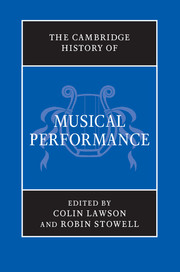Book contents
- Frontmatter
- PART I PERFORMANCE THROUGH HISTORY
- PART II PRE-RENAISSANCE PERFORMANCE
- PART III PERFORMANCE IN THE RENAISSANCE (C. 1430–1600)
- PART IV PERFORMANCE IN THE SEVENTEENTH CENTURY
- PART V PERFORMANCE IN THE ‘LONG EIGHTEENTH CENTURY’
- 20 Performance in the ‘long eighteenth century’: an overview
- 21 Vocal performance in the ‘long eighteenth century’
- 22 Instrumental performance in the ‘long eighteenth century’
- 23 Case study: Mozart, Symphonies in E flat major K543, G minor K550 and C major K551
- PART VI PERFORMANCE IN THE NINETEENTH CENTURY
- PART VII THE TWENTIETH CENTURY AND BEYOND
- PART VIII
- Index
23 - Case study: Mozart, Symphonies in E flat major K543, G minor K550 and C major K551
from PART V - PERFORMANCE IN THE ‘LONG EIGHTEENTH CENTURY’
Published online by Cambridge University Press: 28 March 2012
- Frontmatter
- PART I PERFORMANCE THROUGH HISTORY
- PART II PRE-RENAISSANCE PERFORMANCE
- PART III PERFORMANCE IN THE RENAISSANCE (C. 1430–1600)
- PART IV PERFORMANCE IN THE SEVENTEENTH CENTURY
- PART V PERFORMANCE IN THE ‘LONG EIGHTEENTH CENTURY’
- 20 Performance in the ‘long eighteenth century’: an overview
- 21 Vocal performance in the ‘long eighteenth century’
- 22 Instrumental performance in the ‘long eighteenth century’
- 23 Case study: Mozart, Symphonies in E flat major K543, G minor K550 and C major K551
- PART VI PERFORMANCE IN THE NINETEENTH CENTURY
- PART VII THE TWENTIETH CENTURY AND BEYOND
- PART VIII
- Index
Summary
Mozart today
The original sound world of Mozart's last three symphonies can arguably never be recreated, if only because the evidence is fundamentally insufficient. In any case, to what extent can modern taste cope with primary materials that are sometimes decidedly uncomfortable? This is a fundamental question, since it would be scarcely surprising if the many intricacies of Mozart's last symphonies were not revealed at their premieres. It further seems likely that subsequent early performances would not have exhibited the degree of standardisation and consistency to which we have become accustomed. If this chapter cannot aspire even to speculate effectively, it can at least aim to open up some fruitful areas for reflection. The example of twentieth-century composer Edward Elgar is instructive; his own recordings from the 1920s and 1930s remain readily available yet have never been truly recreated, despite their primary perspective on both performance styles and technical standards. This would surely be true of aural evidence from 140 years earlier, were we to possess it.
- Type
- Chapter
- Information
- The Cambridge History of Musical Performance , pp. 552 - 574Publisher: Cambridge University PressPrint publication year: 2012



